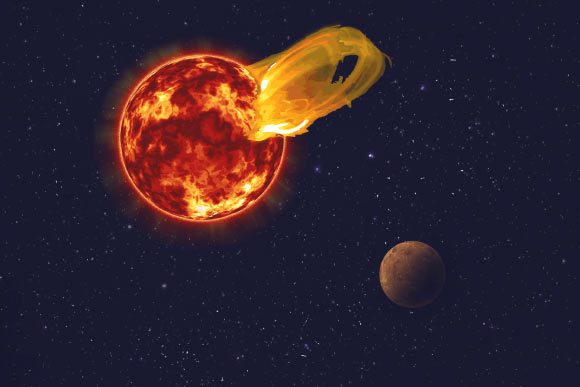Using data from the Atacama Large Millimeter/submillimeter Array (ALMA), astronomers discovered that a giant stellar flare erupted from Proxima Centauri — the star closest to our Sun — on March 24, 2017. This finding raises questions about the habitability of the recently-discovered Earth-mass planet Proxima b.

An artist’s impression of a flare from Proxima Centauri, modeled after the loops of glowing hot gas seen in the largest solar flares. An artist’s impression of the exoplanet Proxima b is shown in the foreground. Proxima b orbits its star 20 times closer than the Earth orbits the Sun. A flare 10 times larger than a major solar flare would blast Proxima b with 4,000 times more radiation than the Earth gets from our Sun’s flares. Image credit: Roberto Molar Candanosa, Carnegie Institution for Science / NASA / SDO / JPL.
Stellar flares happen when a shift in the star’s magnetic field accelerates electrons to speeds approaching that of light.
The accelerated electrons interact with the highly charged plasma that makes up most of the star, causing an eruption that produces emission across the entire electromagnetic spectrum.
At its peak, the newly recognized stellar flare was 10 times brighter than our Sun’s largest flares, when observed at similar wavelengths.
The flare increased Proxima Centauri’s brightness by 1,000 times over 10 seconds.
This was preceded by a smaller flare; taken together, the whole event lasted fewer than two minutes of the 10 hours that ALMA observed the star between January and March of last year.
“March 24, 2017, was no ordinary day for Proxima Centauri,” said Dr. Meredith MacGregor, an astronomer at the Carnegie Institution for Science and lead author of a paper published in the Astrophysical Journal Letters (arXiv.org preprint).
“It’s likely that Proxima b was blasted by high energy radiation during this flare. It was already known that Proxima Centauri experienced regular, although smaller, X-ray flares.”
“Over the billions of years since Proxima b formed, flares like this one could have evaporated any atmosphere or ocean and sterilized the surface, suggesting that habitability may involve more than just being the right distance from the host star to have liquid water.”
An earlier paper that also used the same ALMA data interpreted its average brightness, which included the light output of both the star and the flare together, as being caused by multiple disks of dust encircling Proxima Centauri, not unlike our own Solar System’s asteroid and Kuiper belts.
But when Dr. MacGregor and co-authors looked at the ALMA data as a function of observing time, instead of averaging it all together, they were able to see the transient explosion of radiation emitted from Proxima Centauri for what it truly was.
“There is now no reason to think that there is a substantial amount of dust around Proxima Centauri,” said Dr. Alycia Weinberger, also from the Carnegie Institution for Science.
“Nor is there any information yet that indicates the star has a rich planetary system like ours.”
_____
Meredith A. MacGregor et al. 2018. Detection of a Millimeter Flare from Proxima Centauri. ApJL 855, L2; doi: 10.3847/2041-8213/aaad6b







